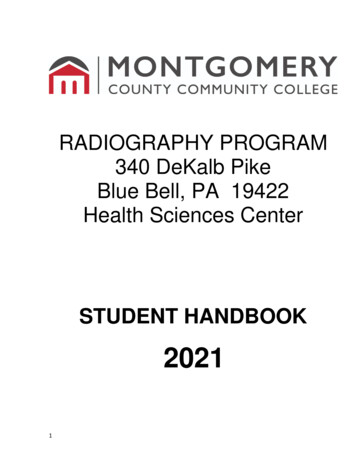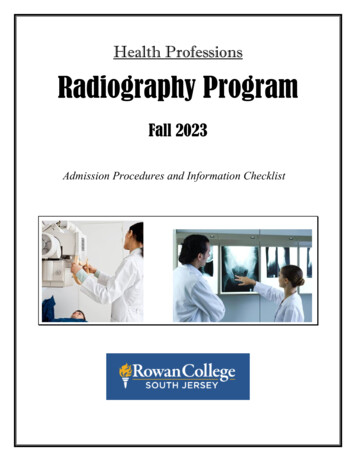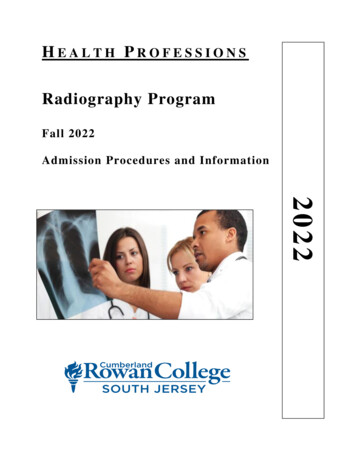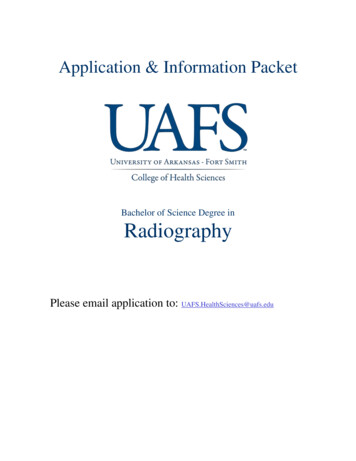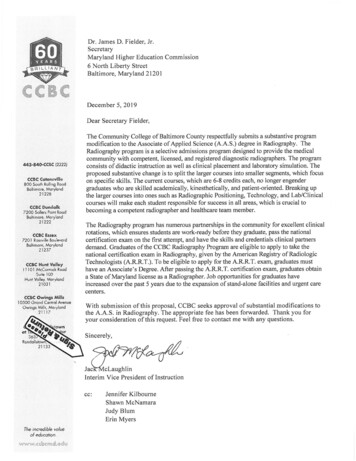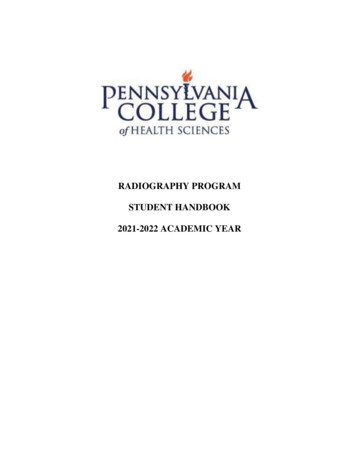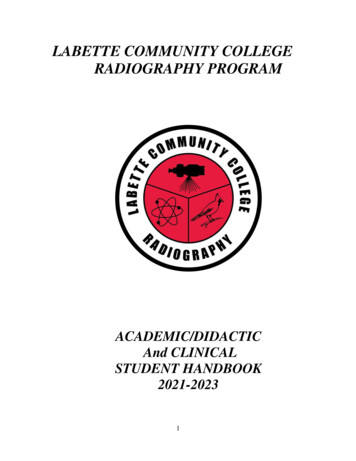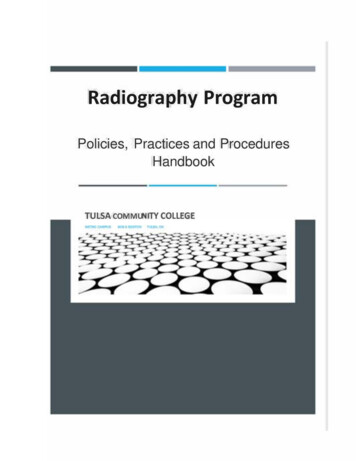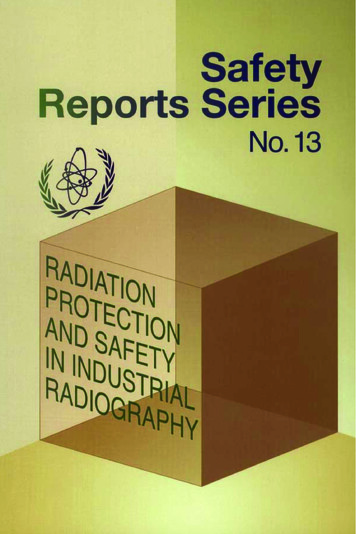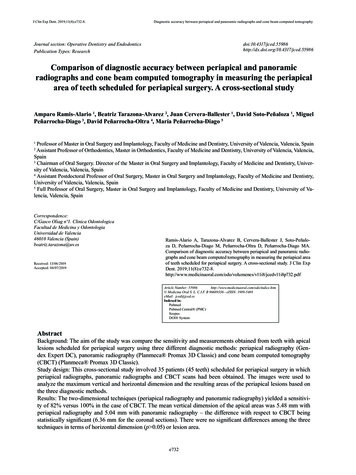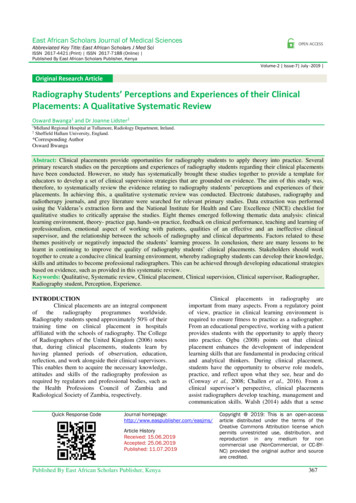
Transcription
East African Scholars Journal of Medical SciencesAbbreviated Key Title: East African Scholars J Med SciISSN 2617-4421 (Print) ISSN 2617-7188 (Online) Published By East African Scholars Publisher, KenyaVolume-2 Issue-7 July -2019 Original Research ArticleRadiography Students’ Perceptions and Experiences of their ClinicalPlacements: A Qualitative Systematic ReviewOsward Bwanga1 and Dr Joanne Lidster21Midland Regional Hospital at Tullamore, Radiology Department, Ireland.Sheffield Hallam University, England.2*Corresponding AuthorOsward BwangaAbstract: Clinical placements provide opportunities for radiography students to apply theory into practice. Severalprimary research studies on the perceptions and experiences of radiography students regarding their clinical placementshave been conducted. However, no study has systematically brought these studies together to provide a template foreducators to develop a set of clinical supervision strategies that are grounded on evidence. The aim of this study was,therefore, to systematically review the evidence relating to radiography students’ perceptions and experiences of theirplacements. In achieving this, a qualitative systematic review was conducted. Electronic databases, radiography andradiotherapy journals, and grey literature were searched for relevant primary studies. Data extraction was performedusing the Valderas’s extraction form and the National Institute for Health and Care Excellence (NICE) checklist forqualitative studies to critically appraise the studies. Eight themes emerged following thematic data analysis: clinicallearning environment, theory- practice gap, hands-on practice, feedback on clinical performance, teaching and learning ofprofessionalism, emotional aspect of working with patients, qualities of an effective and an ineffective clinicalsupervisor, and the relationship between the schools of radiography and clinical departments. Factors related to thesethemes positively or negatively impacted the students’ learning process. In conclusion, there are many lessons to belearnt in continuing to improve the quality of radiography students’ clinical placements. Stakeholders should worktogether to create a conducive clinical learning environment, whereby radiography students can develop their knowledge,skills and attitudes to become professional radiographers. This can be achieved through developing educational strategiesbased on evidence, such as provided in this systematic review.Keywords: Qualitative, Systematic review, Clinical placement, Clinical supervision, Clinical supervisor, Radiographer,Radiography student, Perception, Experience.INTRODUCTIONClinical placements are an integral graphy students spend approximately 50% of theirtraining time on clinical placement in hospitalsaffiliated with the schools of radiography. The Collegeof Radiographers of the United Kingdom (2006) notesthat, during clinical placements, students learn byhaving planned periods of observation, education,reflection, and work alongside their clinical supervisors.This enables them to acquire the necessary knowledge,attitudes and skills of the radiography profession asrequired by regulators and professional bodies, such asthe Health Professions Council of Zambia andRadiological Society of Zambia, respectively.Quick Response CodeClinical placements in radiography areimportant from many aspects. From a regulatory pointof view, practice in clinical learning environment isrequired to ensure fitness to practice as a radiographer.From an educational perspective, working with a patientprovides students with the opportunity to apply theoryinto practice. Ogbu (2008) points out that clinicalplacement enhances the development of independentlearning skills that are fundamental in producing criticaland analytical thinkers. During clinical placement,students have the opportunity to observe role models,practice, and reflect upon what they see, hear and do(Conway et al., 2008; Challen et al., 2016). From aclinical supervisor’s perspective, clinical placementsassist radiographers develop teaching, management andcommunication skills. Walsh (2014) adds that a senseJournal e HistoryReceived: 15.06.2019Accepted: 25.06.2019Published: 11.07.2019Published By East African Scholars Publisher, KenyaCopyright @ 2019: This is an open-accessarticle distributed under the terms of theCreative Commons Attribution license whichpermits unrestricted use, distribution, andreproduction in any medium for noncommercial use (NonCommercial, or CC-BYNC) provided the original author and sourceare credited.367
Osward Bwanga &Joanne Lidster; East African Scholars J Med Sci; Vol-2, Iss- 7 (July, 2019): 367-380of personal satisfaction in facilitating the developmentof students’ sharing practice and enhancing learning,may result.The College of Radiographers of the UK(2012) has emphasised the need to have conduciveclinical learning environments for radiography students.However, it is challenging to provide a suitablyconducive environment for learning because practicebased learning takes place in a demanding and complexenvironment where patient care is provided as well asstudent learning. Radiography students learn in acomplex sociotechnical environment, often withcritically ill patients, and are themselves at risk fromionising radiation. Learning activities are alsounstructured and unplanned. For this reason,radiography students may experience a lot of factorswhich may facilitate or inhibit their clinical learningprocess. The Health Department of Australia andHuman Services (2016) categorises these factors intointernal and external. The internal factors are thosewhich are controlled by the clinical departments, suchas equipment, staffing levels, resources, departmentalpolicies and preparations of clinical supervisors. On theother hand, external factors are those not controlled bythe clinical department, such as patient case load, levelsof funding, accreditation requirements and professionalstandards.In view of the above, radiography studentsexperience challenges during their clinical placements.The first challenge reported in the literature relates todepartmental workload. X-ray departments are usuallybusy with limited teaching time. In a study conducted inthe UK by Fowler and Wilford (2015), radiographystudents expressed concern with an increase in theworkload. This resulted in radiographers not payingattention to students’ learning needs. The secondchallenge is a lack of trained clinical supervisors. Themajority of clinical supervisors in radiography aroundthe world have received little to no training ineducational principles (Sutton, 2013; Cunningham etal., 2015). The lack of training in clinical supervisionmay lead to a trial and error method of teaching, whichwould hinder students’ learning experiences. The thirdchallenge identified in the literature is a lack ofplanning as teaching and learning in clinicalenvironments is often been opportunistic. In order toprovide an effective learning process, clinicalsupervisors should define the expected learningoutcomes and communicate them to students. Thefourth challenge is a lack of support to radiography East African Scholars Publisher, Kenyastudents with learning difficulties. In a study conductedin the UK by Murphy (2010), dyslexic radiographystudents reported that radiographers do not fullyunderstand what learning difficulties are, resulting inlittle or a lack of support.Several research studies have investigatedradiography students’ perceptions and experiences oftheir clinical placements. However, no study to date hassystematically brought these studies together to provideevidence to educators on which to base their decisionsabout effective clinical placements. Due to the lack ofrobust evidence on this topic and with a view toimproving clinical training in Zambia, a review ofexisting research on this subject was deemed of interestto the researcher.Purpose of the StudyThe aim of this study was to systematicallyreview the evidence relating to radiography students’perceptions and experiences of their clinicalplacements.The objectives of this study were: To search for primary qualitative research studieson radiography students’ perceptions andexperiences of their clinical placements. To collect data on radiography students’perceptions and experiences of their clinicalplacements. To systematically extract data from the includedstudies for review. To critically appraise all relevant primaryresearch studies for review. To synthesise the evidence on radiographystudents’ perceptions and experiences of theirclinical placements. To make recommendations that could improvethe quality of clinical placements in radiography.METHODOLOGYA qualitative systematic review method wasemployed in conducting this study. Khan et al., (2011)define a systematic review as a research method thatidentifies relevant studies, appraises their quality andsummarises their findings using a scientificmethodology. In this study, the qualitative approachwas chosen as the researcher was interested in getting adeeper understanding of students’ perceptions andexperiences of their clinical placements (BettanySaltikov, 2012; Polit & Beck, 2017).368
Osward Bwanga &Joanne Lidster; East African Scholars J Med Sci; Vol-2, Iss- 7 (July, 2019): 367-380The following inclusion and exclusion criteria were defined in the study protocol (Table 1). Table 1: Inclusion and exclusion criteria for the studyInclusion criteriaExclusion criteriaStudies focusing on undergraduate Studies focusing on radiographers and students fromradiography students (diagnostic &other healthcare professionalstherapy)Studies that focus on radiography students’ Studies that focus on radiography students’ perceptionsperceptions and experiences of theirand experiences of classroom teaching and learningclinical placementsStudies conducted by qualitative research Studies conducted by quantitative and mixed methodsdesignresearch designs Studies published in English Studies not written in English Studies published from 2006 onwardsPrimary research studies carried out allover the world Studies published before 2006Systematic reviews, reports and expert opinionsSystematic reviews, reports and expert opinions wereexcluded since there are not primary research studies.Due to the continuous advancement in technology andresearch, studies published before 1st January 2006 werealso excluded. Furthermore, non-English studies wereexcluded, as it was considered costly and timeconsuming to hire translators.Searching for Relevant LiteratureA literature search was conducted betweenAugust and December 2016 using the terms“radiography or radiotherapy students AND clinicalplacement or clinical practice AND perceptions orexperiences”. This involved both electronic and manualsearching. The electronic searches were performedusing 4 databases- CINAHL, PubMed/MEDLINE,Scopus and ScienceDirect. Hand searching ofradiography and radiotherapy journals, unpublishedpapers, cited references, as well as the contacting ofexperts were also performed to avoid missing relevantliterature.Selection of Relevant StudiesThe purpose of the study selection process wasto identify studies from both electronic and manualsearches that definitely addressed the purpose of thisreview. The process involved the searching of primarystudies, selecting them according to the inclusion/exclusion criteria (Table 1), screening titles andabstracts, and retrieving potential studies in order toobtain the final studies that were included in thisreview.A combined initial literature search yielded659 articles. Amongst the 659 articles, 640 wereidentified from databases, 8 were studies from journals,2 were from grey literature, 3 came from contactingexperts, and 6 studies from cited references. Afterremoving 18 duplicates, approximately 641 articleswere screened based on reading their titles andabstracts. Following the reading of titles and abstracts,44 studies were selected for retrieval and detailedassessment. 44 of these were selected for detailedassessment, but only 9 met the inclusion criteria for thisstudy. The literature search strategy is illustrated inFigure 1.Figure 1: Flow chart showing literature search strategy East African Scholars Publisher, Kenya369
Osward Bwanga &Joanne Lidster; East African Scholars J Med Sci; Vol-2, Iss- 7 (July, 2019): 367-380The characteristics of the included studies (N 9) are presented in Table 2, while excluded studies (N 35) and reasons forexclusion are presented in the Appendix 1.Table 2: Characteristics of included studies (N 9)NoAuthorYear1Conway etal.,20082Dungey20093Fortsch etal.,20094Williams &Decker20095Bolderston& Morgan20106Sutton20137Mifsud etal.,20158Thanh Leet al.,9Challen etal.,20152016TitleFinal-year diagnosticradiography students' perceptionof role models within theprofessionWhat effect does treating cancerpatients have on radiationtherapy students' identitydevelopment?Connecting the classroom toclinical practice: A comparisonof programsMature students’ perspectives ofstudying radiographyDesign and datacollection blisher orJournalCountry13Journal ofAllied HealthAustraliaQualitativeOpen tativeInterviews,observation and 8Journal ofMedicalImaging bal impact: An examinationof a Caribbean radiation therapystudent placement at a CanadianTeaching HospitalA focused ethnography ofradiotherapy students’ learningon their first clinical placementRadiography students’ clinicalplacement experiences in MRI:A phenomenological studyQualitative-Focusgroup discussionA study of studentradiographers’ learningexperiences in imaging obesepatientsA qualitative study ofperceptions of professionalismamongst radiography studentsData Extraction and Quality AssessmentThe data extraction process involved goingback to the selected studies and highlighting therelevant information to meet the objective of this reviewand extracting data relating to population, exposure andoutcome or themes. In order to standardise this processand improve the validity of the results, the revieweremployed a validated data extraction form developed byValderas et al., (2012). The data extraction formincluded information relating to the year of publication,study design, participant characteristics, data collectioninstrument, main findings, the results of the criticalappraisal and reference for each study (Appendix 2).The reviewer started extracting the data by readingthrough the results of all included studies a number oftimes to become fully immersed with the data. Thereviewer then colour-coded the themes into positive(green) and negative (blue) perceptions and experiencesmanually. The texts highlighted were then entered onthe data extraction form for each of the included studies East African Scholars Publisher, KenyaQualitative Interviews andobservationQualitative Interviews taQualitative -Focusgroup and reflections31Journal ofMedicalImaging andRadiationSciencesAustraliaQualitative -Focusgroup17RadiographyEstoniaunder the themes section. The colour code and pagenumbers were also entered.As part of the systematic review process, allincluded studies were assessed for quality. The qualityof a study may be defined as the degree to which itemploys the measures to minimise bias and error in itsdesign, conduct and analysis (Khan et al., 2011). Thestudies were judged with regard to authenticity andtrustworthiness. The reviewer employed the appraisaltool for qualitative studies developed by the NationalInstitute for Health and Care Excellence (2013) in orderto ensure that studies were assessed in a systematicmanner. The NICE appraisal tool (Appendix 3) waschosen because it has been validated and contains only7 sections, allowing a rapid evaluation of each study.Studies were ranked in three categories of quality (high,moderate and low) according to the proportion of thetotal items with which they comply with the checklist.370
Osward Bwanga &Joanne Lidster; East African Scholars J Med Sci; Vol-2, Iss- 7 (July, 2019): 367-380All included studies were found to have had a highquality in methodology.Data SynthesisData synthesis involved combining thefindings from the included studies and categorised themon the basis of similarity using thematic analysis.Thematic data analysis was then conducted according tothe four steps recommended by Maltby et al., (2010):familiarisation with collected data, identification ofthemes, clustering, and naming of the themes.RESULTSClinical Learning EnvironmentAll the studies included in this reviewidentified issues relating to a conducive clinicallearning environment. According to the ographers who helped them to settle. This was saidto be helpful in building relationships with staff andpatients. Students reported being scared and nervous ontheir first clinical placement, as shared by one student:“When I first started it was very overwhelming asI’d never really had anything to do with sick peopleand I felt as though I was expected to understandwhat they were going through. I was quite scaredand anxious (Dungey, 2009, p 12)”.Some students appreciated a clinical learningenvironment which was supportive, with good workingrelationships. This was perceived by students toproduce positive learning experiences. One student hadthis to say:“Whenever I have a problem, I feel like I can alwaysgo to them and they will listen (Fortsch et al., 2009,p 118).Students reported that they felt confident andmotivated to learn in an environment where they wereaccepted as learners. However, some students reportedfeeling unwelcome which made them uncomfortable:“At times I felt excluded from the rest of theteam, which sometimes made me feel out of place.Sometimes they stayed talking together and since thereis a long waiting time during magnetic resonanceimaging (MRI) scanning you feel uncomfortable andyou stay there listening to them talk. They talked aboutpersonal things and you feel uncomfortable becauseyou do not want to interfere in their discussion (Mifsud,2015, p 18)”.Some students preferred a clinical learningenvironment which allowed them freedom whilstsimultaneously providing support so that they developconfidence and responsibility. This was best illustratedin the following extract: East African Scholars Publisher, Kenya“I like to be in the room by myself and theradiographers may be just right outside. If I can’tfigure this out, then I call them in (Fortsch et al.,2009, p 117)”.Generally, students were grateful for thesupervision received during their clinical placements.However, some students felt unsupervised and this wasreported to have impacted negatively on their learningprocess. One student stated that:“It was the fact that I had to find time to talk to themthat was quite annoying from my side because Ididn’t want to interrupt them, but I would havepreferred if someone had given me some moreattention instead of having to ask everything myself(Mifsud et al., 2015, p 19)”.All comments above indicate that the creationof a conductive clinical learning environment was animportant factor in the facilitation of students’ learning.Theory-Practice GapThree out of the nine studies in this reviewidentified that there was a disparity between the theorytaught in the classroom and what is practiced in theclinical environment. This theme had three ofessionalism and infection control. Studentsunderstood that learning takes place when they applytheory into the reality of radiography, as it enhancestheir learning. One student stated that:“I feel like the University is pretty useful though,like you do read a basis from somewhere, but itssmall tricks that you learn from clinical placements(Thanh Le et al., 2015, p 63)”.Some students reported that there aredifferences in radiographic techniques between what istaught and practiced: “You do learn textbook typepatient cases at University, then you go out and it’s likewow, this is so different and you have to learn differenttechniques and adjust your technique (Thanh Le et al.,2015, p 65)”. Other students also indicated thatprofessional behaviour differs between what is taughtand practiced. One of the students had this to say:“College is the place where professionalism istaught to us to a large extent, and clinical placementgives us an opportunity to reflect upon all of it andcompare with it and often things are not soprofessional in hospitals (Challen et al., 2016, p4)”.Other students witnessed disparity regarding infectioncontrol. One student said:“I was scared when I saw a radiographerapproached a patient with a skin infection withoutwearing any gloves. I thought that she might catch371
Osward Bwanga &Joanne Lidster; East African Scholars J Med Sci; Vol-2, Iss- 7 (July, 2019): 367-380the infection. It was scary (Challen et al., 2016,p4)”.This study revealed that some radiographystudents were confused during their clinical placementsbecause of conflict between theory and practice. Thiswas reported as a negative experience because studentsdid not know whom to believe between the academicand clinical staff.Hands-on PracticeAll studies included in this review revealed theimportance of hands-on practice. Students appreciatedthe importance of connecting theory with clinicalexperiences, as it facilitates the learning process. Onestudent noted that:“There is so much information definitely worthhaving clinical placement. It helps to relate all thatstuff so you can put the information somewhereinstead of just storing it up in your mind (Fortsch etal., 2009, p 116)”.Some radiography students felt that having asmall number of students per clinical supervisorcontributed to a positive learning experience. This wasexpressed by one student who undertook aninternational clinical experience:“Back home (Trinidad and Tobago) there are morestudents to a therapist. It was difficult because youdid not have one to one. If there were three of us, wewould have to take turns to go in with the patient,whereas here (Canada) it is just one student with allthe therapists on your own unit. You get to learneverything. Back home it was more of a fight tolearn (Bolderston & Morgan, 2010, p 155)”.All the reviewed studies reported that studentswere given opportunities to apply theory into practice ingeneral radiography. This was valued by students as apositive clinical learning experience, as it helped themto develop confidence and competence. However, somestudents described specialised imaging, such asComputed Tomography (CT) and Magnetic ResonanceImaging (MRI), as lacking hands-on practice. Onestudent said:‘‘In bone density we scanned patients ourselves. Indental we performed dental X-rays so that when youhave these things, you get more hands on and yourealise and get to know more about theradiographers’ work entails. Whilst when I went toMRI the only thing I had to do was screening, youfocus on screening and you might sort of sidelinedthe rest, because the rest is not as important (Mifsudet al., 2015, p19).A lack of hand on practice in CT and MRI wasreported to have negatively impacted the students’ East African Scholars Publisher, Kenyalearning process in specialised imaging modalitiesduring their clinical placements.Feedback on Clinical PerformanceThis review found that feedback is an essentialelement of clinical education. Two studies revealed thatstudents valued timely and frequent feedback giventhroughout the day by their clinical supervisors. Thiswas said to be helpful in identifying their strengths andweaknesses and to make needed changes before the endof the clinical placement. Unfortunately, some studentsreported a lack of feedback on their clinicalperformance. One student complained that:“They should give us feedback, halfwaythrough or at the end or both or set aside time just tosay ‘How’s it going? What do you think? (Sutton, 2013,p161)”.However, in a study by Fortsch et al., (2009, p117), radiography students reported being satisfied withthe feedback received from radiographers during theirplacements as it was timely and constructive. This wasreported as a positive experience to students’ learningprocess.Teaching and Learning of ProfessionalismTeaching professionalism to students throughrole modelling was identified as a powerful force in thedevelopment of their professional identities. Studentsappreciated professional behaviours exhibited byradiographers as it helped them to acclimatise to theprofession. One student said:“The radiation therapist asked the patient whethershe knew about the side effects that may be expectedfrom treatment. She answered gruffly, ‘Yes, I do!However, I do not want to talk about it’. I wasstunned and wondered how a radiation therapistshould respond to such an answer. I observed thatthe therapists politely accepted and respected herdecision without further questions and noticed thatthey remained calm and professional throughout thetime. In addition, after her treatment, I found thatthe patient appeared relaxed and cheerful(Bolderston & Morgan, 2010, p 155)”.Students also appreciated radiographers whoprovided care and communicated effectively with theirpatients. This was said to be helpful in learningprofessional behaviours. One student said:“During the procedure they stayed talking tohim, they pressed the button to actually stay talking tohim and the way they talked to him, the way they placedwords and how they calmed the patient down during theexamination and also before, allowed me toacknowledge and understand how it had to be done(Mifsud et al., 2015, p 18)”.372
Osward Bwanga &Joanne Lidster; East African Scholars J Med Sci; Vol-2, Iss- 7 (July, 2019): 367-380However, some students expressed that someradiographers did not have good communication skills.This was said to have impacted negatively on theirlearning. One student remarked:“I think there are radiographers along the way thatcan’t really communicate. I find they can’tcommunicate with students or patients. It makes metake a step back and think I don’t want to work withthat radiographer again (Conway et al., 2008, p26)”.Some students also witnessed discriminationof patients by radiographers on the grounds ofnationality and language spoken: One student said.“I have seen discrimination on the grounds ofnationality/language as my parents are of differentnationalities, and I remember one situation in myclinical placement, for example, where all the staffmembers spoke the official language as they allwere native speakers of this language. And thenarrived a patient where are many patients in thatarea who do not speak the official language thenthe radiographers was just pointing with her fingerthat you should lie down here and that’s it . Yourdoctor will get the results (Challen et al., 2016,p4)”.The unprofessional behaviours exhibited bysome radiographers were reported to have hadnegatively impacted on the students’ learning process.Emotional Aspect of Working with PatientsThree out of the nine studies identified theemotional aspect of dealing with very ill patients. In astudy by Mifsud et al., (2015), students felt that MRIprovided the opportunity of building relationships withpatients and in some cases these relationships presentedwith emotional challenges as indicated by the followingcomment:“It is sad to see patients of such young age comingfor an MRI for tumours. I was not accustomed toseeing these children at such a young age passingthrough such a sad period. You feel sorry for themseeing them going through these things. You do notsee these types of things in general X-rays. Ok, youdo see sometimes children, which come for an X-raybecause of a fracture, but you cannot compare afracture with a tumour, (p 19)”.The care of patients with terminal cancer affectedstudents outside work. One student commented that:“I worry much more about the health of my parents,siblings and extended family and friends. Oftenwhen mum or dad have complained of some type ofpain-my initial reaction is ‘oh my goodness it’scancer (Dungey, 2009, p 12)”. East African Scholars Publisher, KenyaIn view of the above, some students expressedconcern with the lack of support in the clinical learningenvironment to students traumatised as a result oftreating terminally ill patients. This was expressed byone student who said: “We have no clinical supervisionin terms of compulsory counselling with people outsidethe department, although I think I would find this reallyuseful (Dungey, 2009, p 13)”.In the reviewed studies, some students facedemotional and technical challenges with the imaging ofobese patients, especially those on life supportmachines. One student said:“It also depends on the state they are in. Like, saythere are in ICU, but they have got too many tubescoming out of them then you are more worried aswell (Thanh Le el al., 2015, p 64)”.These emotions were reported to haveimpacted negatively on students’ clinical learningexperiences, especially with a lack of special support inthe clinical learning environment.Qualities of an Effective and an Ineffective ClinicalSupervisorFrom the reviewed studies, three qualities ofan effective clinical supervisor were identified: clinicalcompetence, teaching skills and personal dgeable and competent in radiography. This wassaid to be helpful in developing their competence. Onestudent had this to say:“Someone who is highly skilled in radiographictechniques and patient care (Conway et al., 2008, p24)”.Students also appreciated radiographers whodemonstrated teaching skills. This was best sta
Primary research studies carried out all over the world Systematic reviews, reports and expert opinions Systematic reviews, reports and expert opinions were excluded since there are not primary research studies. Due to the continuous advancement in technology and research, studies published before 1st January 2006 were also excluded.
